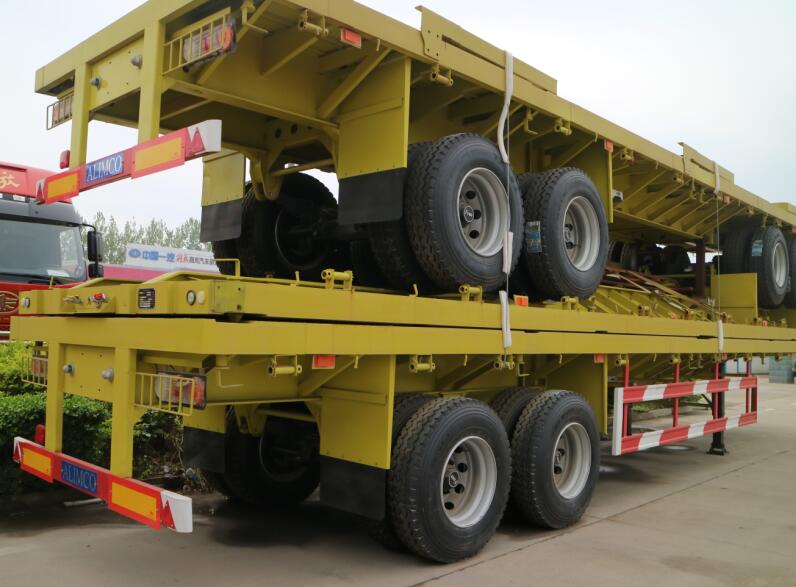The flatbed trailer is a kind of trailer whose design is suitably made to carry bulk cargo and containers between shipping facilities and terminals.
Basically, it is a transport equipment mainly of a steel construction defining its frame. It also comprises a lighting system, brakes and tires.
By simple definition, this is a long flat platform of either 20ft, 40ft, 48ft or 53ft length used for carrying shipping containers. The flatbed trailer has no roof or walls to the side.
It is a bare platform on which different container sizes are secured using container locks ready for transportation. They are primarily used for the transportation of bulk cargo.
Table of Contents
One. Basic Specifications of the Flatbed Trailer
The function of a flatbed trailer is made possible through its structure’s design and manufacture.
It is carefully designed to desired heights and weight capacity to safely load and transport cargoes from one location to another.
Each flatbed trailer comes with its own load rating, size alongside other systems as would be needed for its use. These specifications are very useful in helping you buy the right trailer for your operations.
The tables below show key specifications of the 20ft and 40ft flatbed trailers respectively.
| 20ft 2 Axles Flatbed Trailer Specs | |
| Total Weight | 30, 35 T/tons |
| Rated Load | 30 T/tons |
| Tare Weight | 4000 kg |
| Tire Specifications | 825R22.5, 11R20, 12R22.5 |
| No. Of the Tires | 8 |
| Axle Brand | BPW |
| No. Of the Axles | 2 |
| Per load | 13000 kg |
| Pieces of leaf-spring | 10 |
| Suspension | independent stamping steel rigid suspension (or air suspension) |
| Main Beam | Height:450mm-580mm |
| Outside Dimensions (LxWxH) | 20 ft |
| Material of the Main Beam | Q345B manganese plates, automatic submerged arc welded |
| Brake Air Chamber | Four double and two single chambers |
| Floor | Steel Sheet 3mm thickness or diamond plate |
For much bigger operations and loading capabilities such as those of a 40ft container, you will need a larger platform. Here is the specification sheet for the 40ft flatbed trailer.
| 40ft 3 Axles Flatbed Trailer Specs | |
| Total Weight | 45 T/tons |
| Rated Load | 40, 45 T/tons |
| Tare Weight | 7000 kg |
| Tire Specifications | 825R22.5, 11R20, 12R22.5 |
| No. Of the Tires | 12 |
| Axle Brand | BPW |
| No. Of the Axles | 3 |
| Per load | 13000 kg |
| Pieces of leaf-spring | 10 |
| Suspension | Independent stamping steel rigid suspension (or air suspension) |
| Main Beam | Height:450mm-580mm |
| Outside Dimensions (LxWxH) | 40ft |
| Material of the Main Beam | Q345B manganese plates, automatic submerged arc welded |
| Brake Air Chamber | Four double and two single chambers |
| Floor | Steel Sheet 3mm thickness or diamond plate |
Two. Things to Consider When Choosing a Flatbed Trailer
The different types of flatbed trailers are designed for use in different applications. Therefore, it is important to assess your needs before making a choice of the type of flatbed trailer you need. Here are key factors to consider:
- Size: The Flatbed trailer is designed to carry different cargoes and containers: a flatbed for a 20ft container and another for a 40ft. If you need a flatbed for carrying an oversize load, then an extendable flatbed trailer will be the best choice to go for. The choice based on size is usually made putting these requirements into consideration.
- Load Capacity: The load capacity can also determine the type of trailer that you will choose based on your needs. It can range from 10 tons – 80 tons. Again, this should be based on different requirements as defined by the local laws and regulations on such matters. The various flatbed trailers take a considerable size and weight of cargo. However, all are not designed to carry the same amount of weight. On applications where weight considerations are to be made, the 2 axles or 3 axles container chassis trailer can really help. Heavy cargo can comfortably and securely be carried on these strong chassis made of high-yield materials.
- Axles: The different axle capacity is based on transportation needs and requirements. However, every choice based on the axle configuration should also be in line with the local transportation laws and regulations. The different types of flatbed trailers based on axle configuration include those carrying 12.5 tons per axle, 13 tons per axle and those taking 9 tons per axle. Make sure you choose the type permissible in your country based on the stipulated laws and regulations. The number of axles for each trailer is also a vital consideration to make based on the weight of your cargo. The trailer structure is designed to support various wheel axle assemblies at various positions along its length. Your choice should be informed by your cargo needs and the laws regulating the use of flatbed trailers within your jurisdiction.
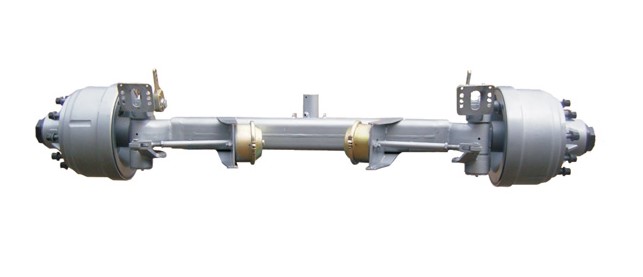
- Tires: Different tire-configurations are used based on the amount of load to be carried. However, this is also regulated through government agencies in respective the countries. There are those that permit a single tire and those who don’t. For single tires, you must make sure that you have a reasonable distribution of tires along the trailer.
Read More:
How to secure load on a flatbed trailer? Use these vital tips!
Three. Different Models of the Flatbed Trailer
3.1 The Common Trailer
This comes in a fixed structure usually used in the loading and movement of containers.
It is a rigid structure of steel construction forming a platform on which containers get loaded and unloaded through the use of overhead cranes.
The common chassis trailer usually comes with a landing gear that plays a key role in enhancing stability during loading and unloading operations.
It comes with well-marked points to facilitate the loading of containers and their transportation to designated locations. This type of trailer is affordable and easy to use.
However, you will need external accessories such as a crane for loading the container onto this platform. If you don’t have this auxiliary equipment ready, operations can get delayed.
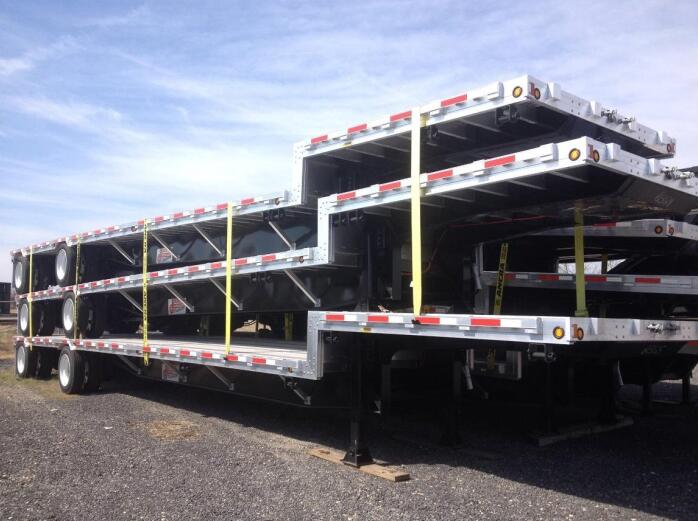
Read More:
What is Semi Flatbed Trailer? Learn Key Specs Affect Capacity, Dimension & Height
3.2 Tilt Flatbed Trailer
This type of trailer offers an easy way of unloading cargo. To facilitate its unloading capabilities, the tilt flatbed trailers come in a different structural design from other types of trailers.
There are apparatus that simplify the loading process onto its bed. Over and above the conventional horizontal platform for carrying the load, the trailer has both lower and upper frames attached to it via a pivot device.
It doesn’t necessarily need auxiliary equipment and systems for loading and unloading cargo from the platform. Operations can be done without using a crane.
There is a hydraulic cylinder installed in it to raise the platform ready for transportation of the loaded cargo.
During the offloading process, the container is set to fall steadily through gravity. The container falls freely backwards once it is unlocked and loosed from the trailer’s top section. This is enhanced with the downward tilting of the trailer.
On touching the ground on its back, the truck moves in the forward direction allowing the container to keep sliding gradually.
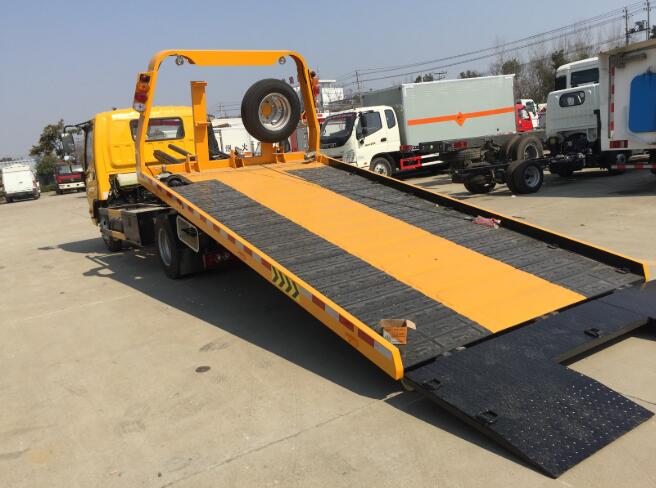
3.3 Extendable Flatbed Trailer
This is a type of flatbed trailers that can adapt to different sizes of cargo. It is commonly used to transport girders, steel tube and steel frames.
It functions the same way as the load positioning chassis but it can be extended at the back section to create room for a much longer cargo that needs to be transported.
Again, it can be adjusted to fit the size of a common trailer. A basic requirement when using flatbed trailers is that the flatbed must be of a greater length than that of the cargo.
The load should be positioned at the floor centre for purposes of maintaining balance and stability during operations. With this type of trailer, one can easily load a cargo that takes almost the entire length of the bed.
Despite the traffic congestion that it may cause in cities, this type of flatbed trailer with an extendable chassis provide unique solutions for handling over-sized cargo. Otherwise, it would be practically impossible to make this type of transportation.
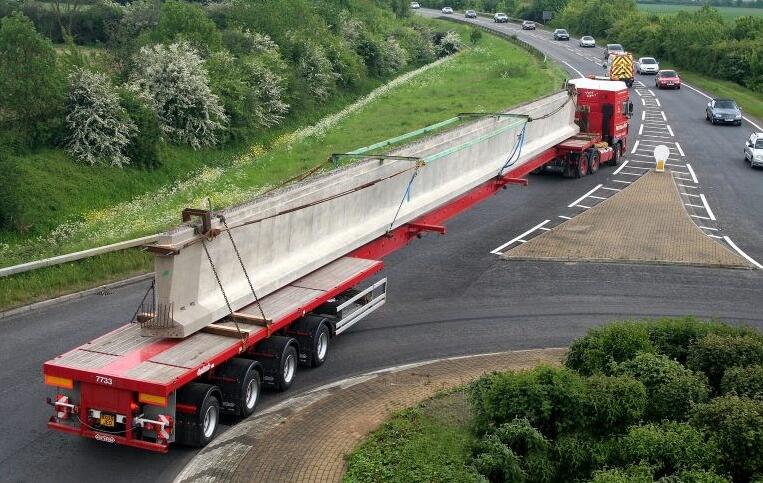
Read More:
Widening / Extendable Trailers Guide – Learn Specs & Design
Conclusion
A flatbed trailer is a very useful platform that is used in the shipping industry. It is primarily used for the transportation of shipping containers of different sizes.
However, it can also be used to take up other different types of loads. These different types of flatbed trailers have different capabilities and usefulness for various applications as discussed in here.
Understanding their operations and basic specifications are vital in helping you choose the type of flatbed trailer you will require for your application. O
ver and above this knowledge of the flatbed trailers and their operation abilities, the local laws and regulations are vital in defining what type of trailer you can use for your operations.

